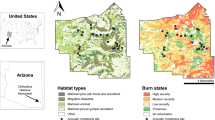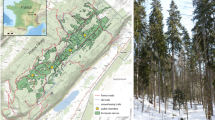Abstract
The soundscape was recorded in four selected places in Sequoia National Park CA, to quantify and assess the diurnal and seasonal character of the park’s soundscape. The recording sites were selected to represent a combination of elevation and vegetation diversity. Hour-long sound recordings were made by four individuals at each place during fall, spring, summer and winter at dawn, midday, dusk, and midnight with identical recording instrumentation. The recordings of the soundscape were made in an old growth forest (Crescent Meadow), in a foothill oak savanna (Sycamore Spring), in an upland savanna chaparral (Shepherd Saddle) and in a foothill riparian location adjacent to the Kiawah River (Buckeye Flat). Sound recordings were analyzed using a normalized Power Spectral Density (PSD) algorithm and partitioned into 1 kHz intervals based on 12 subsamples from each of the 64 h-long sound recordings. Biological signals (biophony) were based on the highest PSD value within the range of 2–8 kHz. A multilevel analysis (MLA) was used to examine temporal patterns of biophony at four locations in Sequoia National Park. Unsupervised Landsat Thematic Mapper Satellite Imagery identified 25 vegetation regimes in Sequoia National Park. Satellite signatures of the habitat where recordings were made were extracted from the imagery to scale to the region.




Similar content being viewed by others
References
Akaike H (1981) Likelihood of a model and information criteria. J Econom 16:3–14
Baptista LF, Gaunt SLL (1997) Bioacoustics as a tool in conservation studies. In: Clemmons JR, Buchholz R (eds) Behavioral approaches to conservation in the wild. Cambridge University Press, Cambridge, pp 212–242
Bates D, Maechler M (2010) lme4: Linear mixed-effects models using S4 classes. R package version 0.999375-37, URL http://CRAN.R-project.org/package=lme4
Dumyahn S, Pijanowski B (2011) Beyond noise mitigation: managing soundscapes as common pool resources. Landscape Ecol. doi:10.1007/s10980-011-9637-8
Gage SH, Napoletano B, Cooper M (2001) Assessment of ecosystem biodiversity by acoustic diversity indices. J Acoust Soc Am 109:2430
Gage SH, Ummadi P, Shortridge A, Qi J, Jella P (2004) Using GIS to develop a network of acoustic environmental sensors. Paper presented at ESRI international user conference 2004, San Diego CA, 9–13 Aug 2004, pp 1–10
Gelman A, Hill J (2007) Data analysis using regression and multilevel/hierarchical models. Cambridge University Press, New York, NY, p 625
Gilat A (2004) MATLAB: an introduction with applications, 2nd edn. John Wiley & Sons, Hoboken
Habib L, Bayne E, Boutin S (2007) Chronic industrial noise affects pairing success and age structure of ovenbirds Seiurus aurocapilla. J Appl Ecol 44:176–184
Hopp SL, Owren MJ, Evans CS (1998) Animal acoustic communication: sound analysis and research methods. Springer-Verlag, Berlin, p 421
Ihaka R, Gentleman R (1996) R: A language for data analysis and graphics. J Comput Graph Stat 5(3):299–314
Krause B (1987) Bioacoustics, habitat ambience in ecological balance. Whole Earth Rev 57:1–6
Krause B (1998) Into a wild sanctuary: a life in music and natural sound. Heyday Books, Berkeley, p 200
Krause B (2002) Wild soundscapes: discovering the voice of the natural world. Wilderness Press, Berkeley
Merlo J, Yang M, Chaix B, Lynch J, Råstam L (2005) A brief conceptual tutorial on multilevel analysis in social epidemiology: investigating contextual phenomena in different groups of people. J Epidemiol Commun H 59:729
Napoletano B (2004) Measurement, quantification and interpretation of acoustic signals within an ecological context, MS thesis, Michigan State University, East Lansing
National Park Service (1995) Report on the effects of aircraft overflights on the National Park System, edited by Department of Interior, Denver, CO
Pijanowski B, Farina A, Gage S, Dumyahn S, Krause B (2011a) What is soundscape ecology? An introduction and overview of an emerging new science. Landscape Ecol. doi:10.1007/s10980-011-9600-8
Pijanowski BC, Villanueva-Rivera LJ, Dumyahn SL, Farina A, Krause BL, Napoletano BM, Gage SH, Pieretti N (2011b) Soundscape ecology: the science of sound in the landscape. BioScience 61:203–216
Pilcher E, Turina F (2008) Visitor experience and soundscapes: annotated bibliography. U.S. Soundcape Workshop. National Park Service and Colorado State University. p 39
R Development Core Team (2010) R: A language and environment for statistical computing, ISBN 3-900051-07-0, URL http://www.R-project.org, R Foundation for Statistical Computing, Vienna, Austria
Schafer RM (1977) Tuning of the world. Knopf Press, New York
Schafer RM (1994) The soundscape: our sonic environment and the turning of the world. Destiny Books, Rochester
Strong D (1996) From pioneers to preservationists: a brief history of Sequoia and Kings Canyon National Parks. Sequoia Natural History Association, Three Rivers, CA
Tweed WT (1982) A guide to and history of the western third of the High Sierra Trail, Crescent Meadow to Kaweah Gap, Sequoia National Park. Sequoia Natural History Association, Three Rivers, CA
Welch P (1967) The use of fast Fourier transform for the estimation of power spectra: a method based on time averaging over short modified periodograms. IEEE T Acoust Speech 15:70–73
Acknowledgments
Rudy Trubitt and Jack Hines provided professional recording expertise and conducted recordings at the selected sites during all seasonal visits. They were also instrumental in processing and archiving acoustic samples. Annie Esperanza was our principal contact at Sequoia National Park and provided significant logistical assistance including recording place selection, laboratory and lodging facilities during recording intervals. Dave Graber, Sequoia National Park Research Superintendent, understood our vision and reason for the study and arranged for recording permits and general access to the Park. Brian Napoletano, a graduate student at Michigan State University, accompanied Gage to the Sequoia National Park on one of the four visits. His MS work focused on quantifying acoustic signals. Susan Wang helped with the classification of the Landsat TM Image used to extrapolate recording places to the park habitats. We thank Steve Friedman for providing important insights and suggestions for improving an earlier version of the manuscript. Finally, we thank Bill Schmidt of the National Park Service for his support, interest and vision. His passing is a significant loss to the NPS and we dedicated this article to him.
Author information
Authors and Affiliations
Corresponding author
Rights and permissions
About this article
Cite this article
Krause, B., Gage, S.H. & Joo, W. Measuring and interpreting the temporal variability in the soundscape at four places in Sequoia National Park. Landscape Ecol 26, 1247–1256 (2011). https://doi.org/10.1007/s10980-011-9639-6
Received:
Accepted:
Published:
Issue Date:
DOI: https://doi.org/10.1007/s10980-011-9639-6




